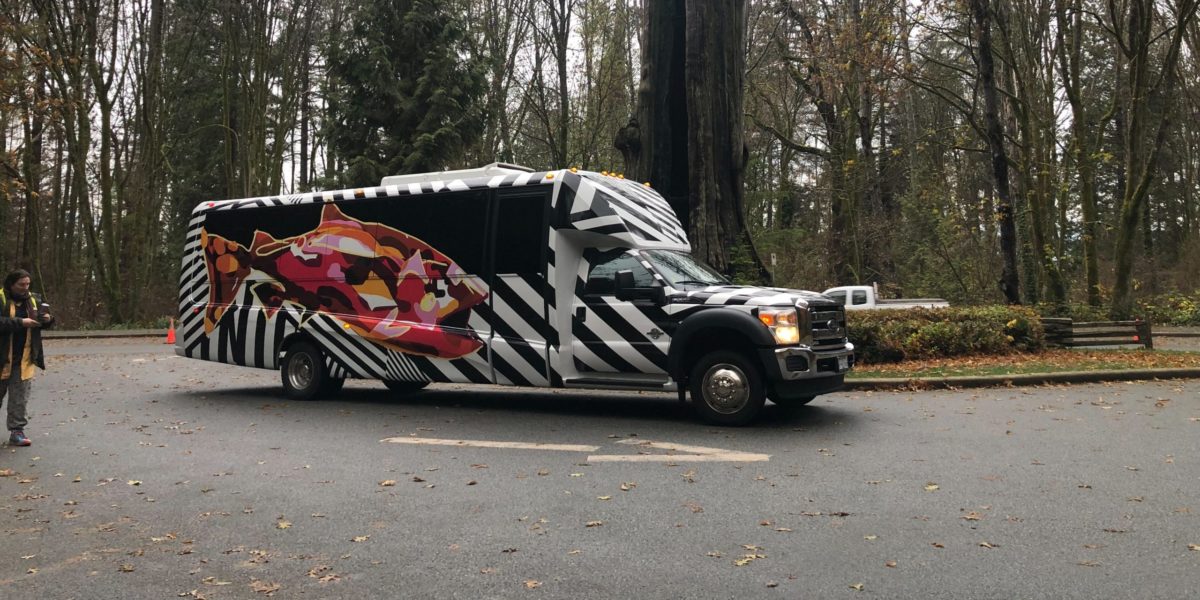If you happened to be walking in Vancouver’s Stanley Park a few days ago, you might have glimpsed a very large Chinook Salmon sitting on the pavement near Nature House. It was there to pick up some mail.
The salmon was actually a shuttle bus, decorated with large, colourful images of the iconic fish (the work of Canadian artist Patrick Thompson). It was one of three “NatureBuses” that are currently making stops across the country to collect messages of support from Canadians for a plan to restore nature. The messages will be delivered to Prime Minister Justin Trudeau in Montreal at this week’s start of the 15th Conference of the Parties (COP 15) to the UN Convention on Biodiversity (“NatureCOP”).
Call it a special delivery for nature… from ordinary citizens.
The problem with big UN events like NatureCOP is that citizens don’t always feel they have a say in the proceedings. These affairs sometimes feel like the stretch limousines of the conference world, with ordinary folks relegated to waving from the sidewalk. But the NatureBus tour has shown that we can make our voices heard inside the big vehicle, even if it’s crowded with VIPs on smartphones.
READ MORE: Good COPs, bad COPs
Each NatureBus stop has brought together local conservation groups and nature lovers to celebrate nature, raise awareness and have fun. The three NatureBuses are traversing different regions of the country—BC, Ontario and the Atlantic provinces. Each is decorated with a species at risk, such as the Loggerhead Shrike, Blanding’s Turtle, Woodland Caribou, the aforementioned Chinook Salmon and the wonderfully named Bohemian Cuckoo Bumble Bee. Artist Patrick Thompson created the images with help from children, the acknowledged experts in wild bus design.
At every stop, the buses collect messages of hope and support for a strong nature agreement and a Canadian action plan to halt and reverse nature loss. In Montreal, the messages—thousands of letters and pieces of artwork—will be delivered to the Canadian Government, and a few of our favourite ones displayed at the Canadian Pavilion at NatureCOP.
All that mail represents one big wave of resolve. Oceanographers talk about the “fetch” of a wave—the distance over which wind blows in one direction. If a strong wind blows over a long fetch, you get a powerful wave. The NatureBus wave covers a fetch almost as large as Canada, and when it breaks in Montreal, expect a big splash. With the evidence of Canadians’ commitment clearly before them, decision-makers at NatureCOP will hopefully be under serious pressure to deliver.
And the world badly needs an agreement in Montreal.
We don’t have to look far for signs of the biodiversity crisis. Last week saw the release of the report Wild Species 2020: The General Status of Species in Canada, which found that one in five wild species in Canada is at risk of extinction. Terry Duguid, parliamentary secretary to the Minister of Environment and Climate Change, was quoted at the press conference as saying that the clock is ticking for species. “Extinction is a very chilling word,” said Mr. Duguid. “Once something is gone, it is gone forever.”
Well said, Mr. Duguid. Except that the Canadian government has no detailed plan for halting and reversing nature loss. Delegates at COP15 are hoping for a new global agreement—the post-2020 Global Biodiversity Framework (GBF)—which will lay out the path for countries to take in order to save nature. That path will be different for each country. In Canada, we need a comprehensive national action plan that includes protecting 30 per cent of land and ocean by 2030 through Indigenous-led conservation, restoring degraded ecosystems and other nature-based climate solutions, ending subsidies harmful to nature, ensuring equitable access to nature, and building new tools and laws to ensure accountability to these targets.
While almost none of the GBF is officially agreed upon, over 100 countries, including Canada, support an ambitious response to the biodiversity crisis. That response must entail (among other things) measurable action across 21 proposed targets to restore and protect nature, in a way that fully respects Indigenous rights. Done properly, and financed equitably, we can stop the extinction and set humanity on a path to live in harmony with nature.
It’s not pie in the sky; it’s life and death. And If leaders can recognize their responsibility to this outcome in Montreal, then the world may just be able to pull it off.
So let’s not miss the bus on this one. NatureCOP provides a once-in-a-decade opportunity for people and the planet.




